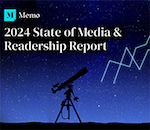Democrats and Republicans exhibit a surprisingly similar range of news-viewing habits, but Republicans tend to be less satisfied than Democrats with the media sources they use, including sources they pay for and use often, according to a July study released by the Media Insight Project, a joint research initiative between The Associated Press-NORC Center for Public Affairs Research and the American Press Institute.
In general, Democrats are more likely than Republicans or independents to believe that the news sources they use for free and the sources they pay for are reliable. According to the study, Democrats are far more likely than Republicans or independents to trust information they receive from the media (30 percent, vs. 8 percent of Republicans and 12 percent of independents).
Among those polled who said they pay for news, 73 percent of Democrats believe their paid sources are very or extremely reliable, versus 53 percent of Republicans, and Democrats are also far more likely than Republicans to believe the sources they subscribe to are a good value (45 percent vs. 30 percent).
 |
Despite myriad differences in political opinion and exhibiting varying levels of trust in the media, the study found that people on both ends of the political spectrum share the same general appetite for news and tend to consume it in similar ways.
About the same percentage of Democrats and Republicans (58 percent vs. 56 percent) are likely to pay for news, both groups claim to seek news out actively rather than passively (68 percent vs. 65 percent) and both demographics claim to get news multiple times a day (72 percent vs. 71 percent).
Both groups are also equally likely (75 percent for each) to get news from social media, with both about equally likely to get news from cell phones (86 percent vs. 84 percent) and computers (66 percent vs. 65 percent). The report also found that Democrats and Republicans are also equally likely to use local news sources, where they tend to follow similar topics such as local politics.
The only media outliers in the study appear to be independents, who are less likely to get news from TVs than Democrats or Republicans (78 percent, vs. 84 percent and 85 percent respectively) and are less likely than Democrats and Republicans to watch, read, hear, or see news at least several times a day (61 percent, vs. 72 percent and 71 percent).
The findings are as the result of two recent Media Insight Project surveys carried out to understand the habits of U.S. news consumers. The first, a study about subscribing to news, interviewed more than 2,000 U.S. adults between February and March. The second comes from a study of people’s trust in news based on interviews with more than 2,000 U.S. adults in March.


 Trump Media & Technology Group today reported a $58.2M net loss on $4.1M in 2023 revenues, a disclosure that drove its stock price down 22.6 percent to $47.96.
Trump Media & Technology Group today reported a $58.2M net loss on $4.1M in 2023 revenues, a disclosure that drove its stock price down 22.6 percent to $47.96. Barry Pollack, an attorney at Wall Street’s Harris St. Laurent & Wechsler, has registered Julian Assange as a client with the Justice Dept. “out of an abundance of caution.”
Barry Pollack, an attorney at Wall Street’s Harris St. Laurent & Wechsler, has registered Julian Assange as a client with the Justice Dept. “out of an abundance of caution.” Paramount Global to slash 800 jobs in what chief executive Bob Bakish calls part of an effort to “return the company to earnings growth"... Rolling Stone editor-in-chief Noah Shachtman is exiting at the end of the month due to disagreements with chief executive Gus Wenner over the direction the magazine is taking... The New York Times broke the $1 billion barrier in annual revenue from digital subscriptions in 2023... Press Forward is investing more than $500 million to strengthen local newsrooms.
Paramount Global to slash 800 jobs in what chief executive Bob Bakish calls part of an effort to “return the company to earnings growth"... Rolling Stone editor-in-chief Noah Shachtman is exiting at the end of the month due to disagreements with chief executive Gus Wenner over the direction the magazine is taking... The New York Times broke the $1 billion barrier in annual revenue from digital subscriptions in 2023... Press Forward is investing more than $500 million to strengthen local newsrooms. The majority of news articles are read within the first three days of publication, according to a recent report.
The majority of news articles are read within the first three days of publication, according to a recent report. The Los Angeles Times gives pink slips to 115 people or 20 percent of its newsroom staff... TIME is also laying off about 30 employees, which is approximately 15 percent of its editorial staff... The Baltimore Banner, which was launched by Stewart Bainum in 2022 after he failed to buy the Baltimore Sun, added 500 subscribers per day in the three days following Sinclair Broadcast Group's deal to purchase the Sun.
The Los Angeles Times gives pink slips to 115 people or 20 percent of its newsroom staff... TIME is also laying off about 30 employees, which is approximately 15 percent of its editorial staff... The Baltimore Banner, which was launched by Stewart Bainum in 2022 after he failed to buy the Baltimore Sun, added 500 subscribers per day in the three days following Sinclair Broadcast Group's deal to purchase the Sun.


 Have a comment? Send it to
Have a comment? Send it to 
No comments have been submitted for this story yet.